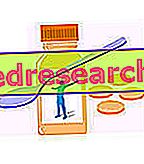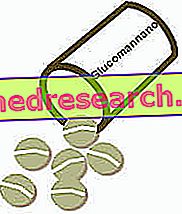Related articles: Alcoholism
Definition
Alcoholism is a set of disorders resulting from an intoxication of the body following the consumption of large quantities of alcohol.
The harmful effects caused by alcoholic beverages are due to the action of ethyl alcohol, a substance that depresses the central nervous system. Once ingested, it is rapidly absorbed at the level of the stomach and intestines and diffuses to all the tissues of the body, but it collects more in the liver and in the brain. The phenomena associated with the immediate action of alcohol manifest themselves more clearly when ingestion takes place on an empty stomach.
The toxicity of alcoholic beverages is proportionate to their content in ethyl alcohol, ie to their alcohol content. When the concentration of alcohol in the blood reaches 200 mg / 100 ml, the first signs of intoxication appear; these become clear with a higher alcohol level. For most subjects, the frequency and amount of alcohol consumption does not compromise physical and mental health or the ability to perform daily activities safely.
Acute alcohol intoxication plays a significant role in trauma, particularly those related to interpersonal violence and traffic accidents. Chronic abuse, on the other hand, interferes with working, relational and social skills.
Alcohol addiction is characterized by an obsessive compulsive search for alcoholic beverages (eg need to drink in the morning, just woken up) and addiction and tolerance (to achieve a certain effect, the individual is forced to drink more and more quantities of alcohol).
Women may be more sensitive to the effects of alcohol than men, since the first-pass metabolism at the gastric level is lower. Drinking during pregnancy, then, increases the risk of fetal alcohol syndrome, which can cause facial dimorphisms (eg cleft lip and palate), delay in growth and abnormalities in the development of the central nervous system.
In any case, alcohol use disorders can occur in anyone, regardless of age, sex, environmental context or social situation.
Most common symptoms and signs *
- Miscarriage
- abulia
- Aphonia
- Aggression
- Hallucinations
- Changes in the menstrual cycle
- Anemia
- anguish
- Anorexia
- Apathy
- Arrhythmia
- Redness of the face
- Asthenia
- Ataxia
- Testicular atrophy
- Catatonia
- ketonuria
- Coma
- Conati
- Convulsions
- Night Cramps
- Delirium
- Delirium tremens
- depersonalization
- Depression
- derealization
- Difficulty concentrating
- Language difficulties
- dysphoria
- Erectile dysfunction
- Dehydration
- Temporal and spatial disorientation
- Dyspnoea
- Mood disorders
- Gastrointestinal hemorrhage
- Hepatitis
- Nervous breakdown
- Euphoria
- Flashback
- Tingling in the right arm
- Tingling in the Left Arm
- Tingling in the right hand
- Tingling in the head
- Tingling in the hands
- Tingling in the legs
- Gynecomastia
- Nightmares
- Insomnia
- hyperreflexia
- Hypertension
- Portal hypertension
- Hypocalcemia
- Hypoaesthesia
- Hypophosphatemia
- Hypoglycemia
- Hypomania
- undernourishment
- weakness
- Hypotension
- hypovitaminosis
- Restlessness
- Social isolation
- Lethargy
- Inflated tongue
- Yellow tongue
- Livedo Reticularis
- logorrhea
- macrocytosis
- Thinness
- Stomach ache
- Headache
- Nausea
- Nervousness
- Nystagmus
- Ophthalmoplegia
- Paresthesia
- Memory loss
- Loss of coordination of movements
- Loss of balance
- presyncope
- Reduced vision
- Growth delay
- Mood swings
- Drowsiness
- Confusional state
- Inflated stomach
- Sweating
- Fainting
- Tachycardia
- teratozoospermia
- Tremors
- thrombocytosis
- Dizziness
- Double vision
- He retched
- Biliary vomiting
Further indications
Acute intoxication
Acute alcoholism manifests itself with an initial state of excitement, which is followed by a phase characterized by a reduction in global psychic efficiency with sedation, uncertain gait and decreased attention, slowing of perceptions and vertigo.
Proportionally at the blood alcohol level, motor incoordination, nystagmus (rapid and uncontrolled movements of the eyes) and awkward speech manifest themselves. Furthermore, in the case of acute alcoholism, memory disorders occur, impaired judgment, decreased behavioral inhibitions, obtundation, delirium and lethargy.
Vomiting is frequent in moderate and severe intoxication. Other effects of acute alcoholism include hypotension, hypoglycemia and loss of consciousness, including coma.
In people unfamiliar with alcohol, high alcohol levels can be fatal (400 mg / 100 ml). Death can occur suddenly due to respiratory depression, especially when large amounts of alcohol are swallowed quickly. Furthermore, a violent death is possible due to road accidents, accidents at work, drowning and violent acts.
Chronic intoxication
Chronic alcoholism derives from an irrepressible and prolonged drinking habit. It is associated with physical manifestations (loss of appetite following gastritis with severe atrophy of the mucosa, asthenia and kidney damage), mental and psychic (alcoholic psychosis) and behavioral (aggressiveness, anger, affective indifference, obtundation and dementia). The chronic intake of alcohol also predisposes to liver diseases, such as fatty liver (fatty liver), alcoholic hepatitis (inflammation of the liver) and cirrhosis, from which an alteration of the coagulation can result. This latter condition increases the risk of severe bleeding due to trauma (eg falls or road accidents) and gastro-intestinal bleeding.
Signs of chronic alcoholism also include Dupuytren's contracture of the palmar fascia and paralysis of the eye muscles (due to vitamin B1 deficiency), and, in men, erectile dysfunction and signs of hypogonadism and feminization (eg gynecomastia and testicular atrophy). ). In women, however, alterations in the menstrual cycle are possible.
The chronic intake of large quantities of alcohol can also lead to the following complications: gastric ulcers, esophagitis, pancreatitis, cardiomyopathy (often accompanied by arrhythmias, arterial hypertension and heart failure), peripheral neuropathy (reduced sensitivity and appearance of tingling in the hands and feet) and malnutrition, in particular vitamin deficiencies. Other possible long-term effects of alcoholism include memory loss and brain damage, including Wernicke's encephalopathy, Korsakoff's psychosis, Marchiafava-Bignami's disease and alcoholic dementia.
The abuse of chronic alcohol also predisposes to a greater susceptibility to infections (due to the reduction of the immune defenses) and to some types of tumors, especially to the digestive tract (eg cancer of the liver, esophagus and stomach).
Alcoholic withdrawal syndrome
The abrupt cessation of chronic alcohol consumption causes the withdrawal syndrome. Usually, within 6-24 hours of suspension, symptoms and signs of hyperactivity of the central nervous system occur, ranging from tremor to convulsions and hallucinations, to delirium tremens.
In the mild form of withdrawal there is weakness, headache, profuse sweating, agitation, restlessness, loss of appetite, nausea and vomiting. Some patients have generalized whole-body tonic-clonic seizures (called alcoholic epilepsy). Hallucinations are typically visual, but can also be tactile, olfactory and auditory, frequently with accusatory and threatening content.
Delirium tremens usually starts 48-72 hours after abstinence from alcohol and represents a medical emergency that can lead to death in 30% of untreated cases. The patient appears alert, but has restlessness, growing confusion, anxiety attacks, disorientation, trembling of the legs and hands, increased heart rate (tachycardia) and body temperature (hyperthermia), sleep disturbances (with terrifying dreams or illusions nocturnal) and severe depression.
Diagnosis and treatment
The diagnosis is often clinical and involves the measurement of blood alcohol levels and glycaemia (acute alcoholism), liver function tests, coagulation profile (PT / PTT) and complete blood count (chronic alcoholism) and investigations to exclude lesions of the central nervous system and infections, such as CT and lumbar puncture (abstinence and severe toxicity).
Alcoholism treatment includes support measures to detoxify the patient and manage alcohol withdrawal syndrome, such as endotracheal intubation and mechanical ventilation in case of apnea or inadequate breathing or intravenous re-hydration. Patients with a severe withdrawal syndrome can be treated with thiamine (to correct any vitamin B1 deficiency) and benzodiazepines (favor behavioral control), until the symptoms have completely disappeared. The treatment of alcoholism also provides an appropriate psychotherapy and adherence to rehabilitation programs dedicated to the treatment of alcohol dependence problems.
Complete abstention from alcohol is strongly recommended during pregnancy, during lactation, in the growth phase, when one must drive and work with delicate or dangerous instruments and while taking drugs.



